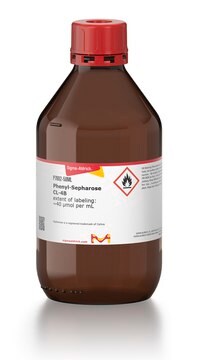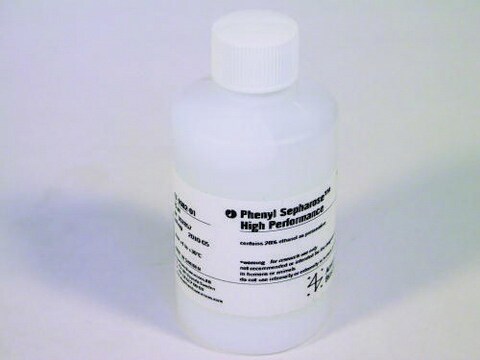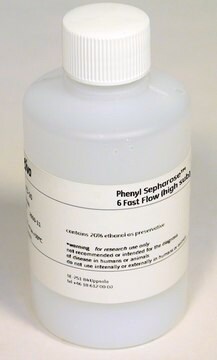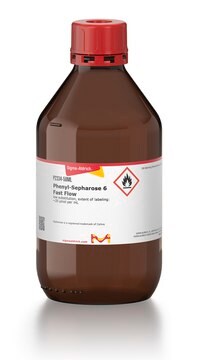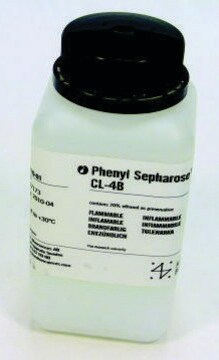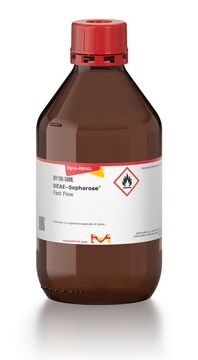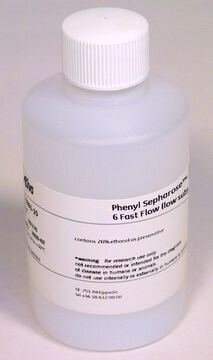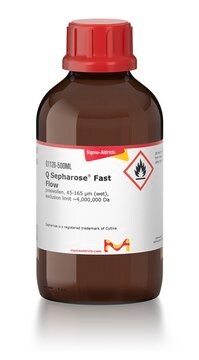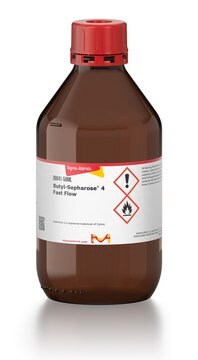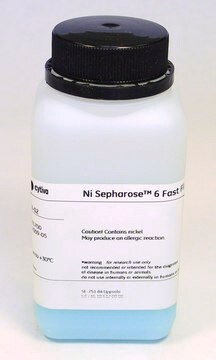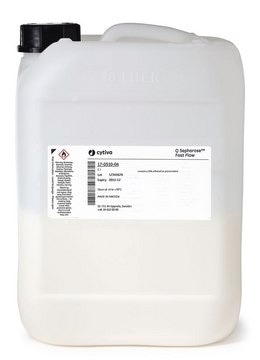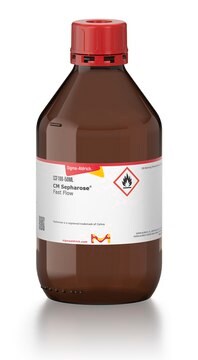P2459
Phenyl-Sepharose 6 Fast Flow
high substitution, extent of labeling: ~40 μmol per mL (high substitution)
Synonim(y):
Phenyl-Agarose
Zaloguj sięWyświetlanie cen organizacyjnych i kontraktowych
About This Item
Polecane produkty
Poziom jakości
Formularz
suspension
zakres etykietowania
~40 μmol per mL (high substitution)
Matryca
agarose, 6% cross-linked
aktywacja macierzy
epichlorohydrin
MAR
ether
spacer macierzy
3 atoms
wielkość cząstki
45-165 μm
temp. przechowywania
2-8°C
Szukasz podobnych produktów? Odwiedź Przewodnik dotyczący porównywania produktów
Opis ogólny
P2459-200ML′s updated product is GE17-0973-05
Zastosowanie
Phenyl Sepharose™ is used in protein chromatography, affinity chromatography, hydrophobic interaction media, resins and separation media. Phenyl Sepharose™ has been used in studies that contributed to improving industrial applications in additives in detergents and feed industries. Phenyl Sepharose™ has also been used to study microbial communities inhabiting hypersaline environments.
Postać fizyczna
Suspension in 20% ethanol
aqueous ethanol suspension
Informacje prawne
Sepharose is a trademark of Cytiva
Ta strona może zawierać tekst przetłumaczony maszynowo.
produkt powiązany
Numer produktu
Opis
Cennik
Hasło ostrzegawcze
Warning
Zwroty wskazujące rodzaj zagrożenia
Zwroty wskazujące środki ostrożności
Klasyfikacja zagrożeń
Flam. Liq. 3
Kod klasy składowania
3 - Flammable liquids
Klasa zagrożenia wodnego (WGK)
WGK 3
Temperatura zapłonu (°F)
104.0 °F
Temperatura zapłonu (°C)
40 °C
Wybierz jedną z najnowszych wersji:
Masz już ten produkt?
Dokumenty związane z niedawno zakupionymi produktami zostały zamieszczone w Bibliotece dokumentów.
Klienci oglądali również te produkty
Frank J Ruzicka et al.
Biochimica et biophysica acta, 1774(2), 286-296 (2007-01-16)
A gene eam in Clostridium difficile encodes a protein that is homologous to lysine 2,3-aminomutase (LAM) in many other species but does not have the lysyl-binding residues Asp293 and Asp330 in LAM from Clostridium subterminale SB4. The C. difficile protein
<I>Candidaguilliermondii</I> grows on rare pentoses ? implications for production of pure xylitol.
Granstrom, T., et al.
Biotechnology Letters, 24, 507-510 (2002)
Dawei Chen et al.
Biochemistry, 45(42), 12647-12653 (2006-10-18)
Lysine 2,3-aminomutase (LAM) from Clostridium subterminale SB4 catalyzes the interconversion of (S)-lysine and (S)-beta-lysine by a radical mechanism involving coenzymatic actions of S-adenosylmethionine (SAM), a [4Fe-4S] cluster, and pyridoxal 5'-phosphate (PLP). The enzyme contains a number of conserved acidic residues
K A Rye et al.
The Journal of biological chemistry, 270(1), 189-196 (1995-01-06)
The effect of cholesteryl ester transfer protein (CETP) on the size, composition, and structure of spherical, reconstituted HDL (rHDL) which contain apolipoprotein (apo) A-I as their sole apolipoprotein has been studied. Spherical rHDL were incubated with CETP and Intralipid for
K A Rye et al.
The Journal of biological chemistry, 271(8), 4243-4250 (1996-02-23)
The effect of sphingomyelin (SPM) on the structure and function of discoidal and spherical reconstituted high density lipoproteins (rHDL) has been studied. Three preparations of discoidal rHDL with 1-palmitoyl-2-oleoyl phosphatidylcholine (POPC)/SPM/unesterified cholesterol (UC)/apolipoprotein (apo)A-I molar ratios of 99.6/0. 0/10.2/1.0, 86.0/13.6/10.8/1.0
Nasz zespół naukowców ma doświadczenie we wszystkich obszarach badań, w tym w naukach przyrodniczych, materiałoznawstwie, syntezie chemicznej, chromatografii, analityce i wielu innych dziedzinach.
Skontaktuj się z zespołem ds. pomocy technicznej